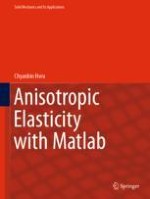2021 | OriginalPaper | Buchkapitel
15. Boundary Element Analysis
verfasst von : Chyanbin Hwu
Erschienen in: Anisotropic Elasticity with Matlab
Aktivieren Sie unsere intelligente Suche, um passende Fachinhalte oder Patente zu finden.
Wählen Sie Textabschnitte aus um mit Künstlicher Intelligenz passenden Patente zu finden. powered by
Markieren Sie Textabschnitte, um KI-gestützt weitere passende Inhalte zu finden. powered by
Abstract
Finite element method (FEM) and boundary element method (BEM) are two important and popular techniques for practical engineering problems. The main advantages of BEM over FEM are the reduction of the problem dimension by one and the exact satisfaction of certain boundary conditions for particular problems if their associated fundamental solutions are embedded in boundary element formulation. To know how BEM works, an overview will be presented in the first Section of this Chapter. To employ the special fundamental solutions for certain particular problems, some fundamental solutions derived from the Green’s functions presented in the previous Chapters are shown in Sects. 15.2 and 15.3 for two-dimensional problems and coupled stretching-bending problems with an infinite space, holes, cracks, inclusions, and interfaces, etc. Following these Sections are the BEMs for two-dimensional anisotropic elastic analysis, piezoelectric/MEE analysis, viscoelastic analysis, thermoelastic analysis, dynamic analysis, coupled stretching-bending analysis, contact analysis, and three-dimensional analysis.
